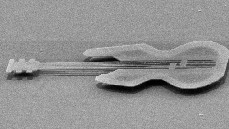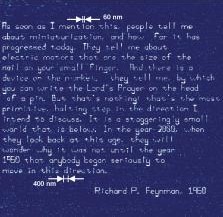Nanoart comes in two flavors:
- works created by artists envisioning our nanotechnological future
- creations and designs produced by nanotechnologists
Let's look at some intriguing examples of nanoart...
Nanoguitar
| microscope (AFM) the nanoguitar can be played, but it cannot be heard as its strings resonate at inaudible frequencies.Its creation demonstrates a new technology that could have a variety of uses in fiber optics, displays, sensors and electronics leading to a new generation of microelectromechanical devices. |
Nanoplotter
In 1998, writing and printing techniques were miniaturized by a research
team led by Chad Mirkin and Charles and Emma Morrison of Northwestern's
Center for Nanotechnology when they created the world's smallest pen,
utilized by an automated four-color nanoplotter.
The nanolithography had previously allowed us to draw tiny lines with only a single ink or type of molecule. Now, with the nanoplotter, multiple inks, or different kinds of molecules can be placed side by side with such accuracy that the chemical purity of each line can be retained.
By 2001, the Northwestern University researchers Seunghun Hong and Mirkinin had invented a nanoplotter that can draw multiple copies of a nanometre-sized pattern: at assorted places on a surface, simultaneously. Their eight-pen nanoplotter could be adapted to use a thousand pens!
Nanoart Galleries
Are there any art galleries exhibiting nanoart? Absolutely! Robert Freitas Jr., a medical nanorobotics theoretician, curates an evolving exhibit of original and previously-published nanoart. His Nanomedicine Art Gallery, hosted by the Foresight Institute, holds a fascinating collection of nanomedicine-related artwork, graphics, illustrations and animations. I can't say I understand the art in this website, but do have a look.
Another website that displays nanoart is the Nano World Gallery. It has only a few pictures, but they are very good.

